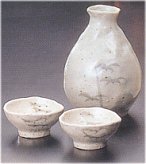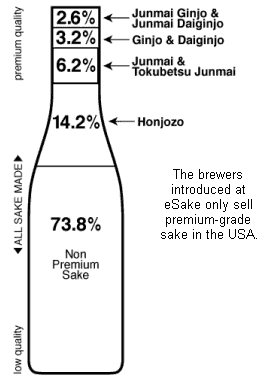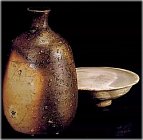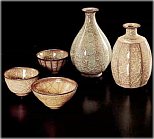|
 Ginjo Sake Equals Premium Sake Ginjo Sake Equals Premium Sake
The term "Ginjo" is synonomous with premium sake, the type of sake exported by
eSake's brewers. Ginjo is not a brand name. It is a style (a grade, category, class) of sake. Ginjo sake is to regular sake what single malt scotch is to regular scotch, or what 100
% agave tequila is to regular tequila. Only 8% to 9% of all sake brewed is Ginjo grade. If you see the term "Ginjo" anywhere on the label, it means the sake you're about to drink
is better than 90% of all sake out there.
Premium versus Non-Premium Sake
Only the highest grades of sake are exported
to the USA by the brewers introduced at eSake.

For more on the various grades of sake,
please visit the Types of Sake page
Ginjo Classification
Government regulations strictly define the meaning of the Ginjo
classification. First and foremost is rice milling, which greatly influences the final taste. To legally qualify as a Ginjo (premium) sake, at least the
outer 40% of the grain must be milled away. For Daiginjo (super premium sake) at least the outer 50% of the rice kernel must be milled away. See below chart for more details. On top of that, special rice
(not table rice), special yeast, lower fermentation temperatures, longer periods of fermentation, and other labor-intensive techniques must be painstakingly followed in brewing Ginjo-level sake.
Best Enjoyed Chilled
Premium Ginjo sake is much more delicate, balanced, fragrant, and complex than non-premium sake (sake with less stringent milling
requirements). That's why Ginjo sake is best enjoyed slightly chilled, for warming or overchilling premium sake tends to mask or destroy its refined flavors. When you warm a premium sake, you bludgeon its true
taste -- you're essentially destroying the flavor intended by the brewer.
Caveats
In Japan, the concept "Ginjo Equals Premium" is authentic and
widespread, yet there are a few drawbacks to this concept. First, some "non-Ginjo" sake are classified as premium sake -- namely Honjozo, Tokubetsu Honjozo, Junmai, and Tokubetsu Junmai. Although these
products fall just below the Ginjo category, they are nonetheless very much premium (at least the outer 30% of the rice kernel is milled away).
Second, Ginjo-level sake comes in various subclasses -- namely Ginjo and Junmai Ginjo, as well as Daiginjo and Junmai Daiginjo. The differences among these subclasses are not clearly conveyed.
|
SEIMAIBUAI (Pronounced "say my boo eye")
Degree to which rice is milled before brewing
|
|
|
Yamada Nishiki Rice
A top-grade sake rice
Unmilled
 |
|
|
45% Milled Away
Seimaibuai = 55%
Ginjo Grade
 |
|
|
55% Milled Away
Seimaibuai = 45%
Daiginjo Grade
 |
|
|
SEIMAI-BUAI (Degree of Milling). Premium sake is brewed with special sake rice in which the
starch component (the shinpaku or "white heart") is concentrated at the center of the grain, with proteins, fats, and amino acids located toward the outside. With increased milling, one can remove more of the fats, proteins, and amino acids that lead to unwanted flavors and aromas in the brewing process. Ginjo-shu (premium sake) has at least 40% or more milled away. Daiginjo (super premium sake) has at least 50% or more milled away. What is the significance of the seimai-buai? The lower the number (i.e., the more the rice has been milled), the cleaner and more elegant the flavor.
|
|
|
OTHER IMPORTANT PARAMETERS
Nihonshu-do: Also called the Sake Meter Value (abbreviated SMV) in
English, this is the specific gravity of a sake. It indicates how much of the sugars created from the starches in the rice were converted to alcohol, and how much remained to contribute to sweetness. By ancient
convention, the higher the number, the drier the sake. What is the range? In theory, it is open-ended. In practice, + 10 or so is quite dry, -4 or so
is quite sweet, and +3 or so is neutral. Keep in mind this parameter is affected by acidity, temperature, accompanying food, and a host of other factors so that it is limited in its usefulness.
Acidity:
A measure of the acid in a sake. Acidity affects how the flavor spreads, and also the sensation of sweet and dry. The range is quite narrow, with 0.7 being low and 2.0 being quite high. Perhaps 1.2 or so
is average.
Rice Varietal: Good sake is made from special sake rice. There are dozens of types of sake rice, which is different from eating rice, but only
a handful that are truly worth remembering. The most important of these is Yamada Nishiki. To learn more about the types of sake rice, click here.
Yeast Strain:
Yeast mainly affects fragrance, and then flavor. There are dozens of yeast strains, each with its own subtly different characteristics, mostly affecting fragrance, but also flavor. Learning to
discern the characteristics of the various yeast strains is part of the fun of learning about sake. To learn more about yeast strains, click here.
Grade: Click here to learn about the various types / grades of sake, including the main types called junmai, honjozo, ginjo, and daiginjo.
 
Happy Sake Sipping
|